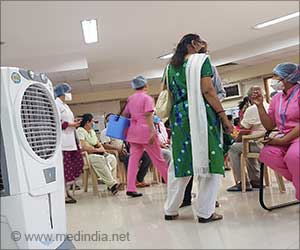- High PM2.5 levels in Delhi and Chennai correlate with elevated blood sugar levels and a 22% increased risk of diabetes
- The Lancet study reveals higher-than-estimated diabetes prevalence in urban India, fueled by a combination of air pollution and lifestyle changes
- PM2.5 exposure not only increases diabetes risk but also raises blood pressure, leading to potential cardiovascular issues
PM2.5 exposure, glycemic markers and incidence of type 2 diabetes in two large Indian cities
Go to source). PM2.5 particles, which are 30 times thinner than a strand of hair, can enter the bloodstream and cause a variety of respiratory and cardiovascular problems when inhaled. The research is part of an ongoing project in India that began in 2010. It is the first research to investigate the link between exposure to ambient PM2.5 and type 2 diabetes in India, one of the world's most polluted countries.
PM2.5 Levels in India Exceed the WHO Limit
According to the study, the average yearly PM2.5 levels in Delhi were 82-100g/m3 and in Chennai were 30-40g/m3, much exceeding the WHO limit of 5g/m3 (2✔ ✔Trusted SourceWHO global air quality guidelines
Go to source). The national air quality standard in India is 40 g/m3 (3✔ ✔Trusted Source
National Ambient Air Quality Standards
Go to source).
India's Burden of Non-Communicable Diseases
According to an article published in the Lancet, India has a high burden of non-communicable diseases such as diabetes, hypertension, and heart disease; 11.4% of the population - 101 million people - has diabetes, and around 136 million are pre-diabetic (4✔ ✔Trusted SourceMetabolic non-communicable disease health report of India: the ICMR-INDIAB national cross-sectional study (ICMR-INDIAB-17)
Go to source). Diabetes prevalence in the European Union was 6.2% in 2019, and 8.6% in the United Kingdom in 2016.
Urban India Has More Diabetics than Rural India
The Lancet study discovered that India's diabetes prevalence was higher than previously estimated, with a greater proportion of diabetics in urban India than in rural India.The researchers followed a group of 12,000 men and women in Delhi and Chennai from 2010 to 2017 and checked their blood sugar levels regularly. They determined the air pollution in each participant's neighborhood throughout that timeframe using satellite data and air pollution exposure models.
Exposure to PM2.5 Increases Risk of Diabetes by 22%
They discovered that one month of PM2.5 exposure resulted in higher blood sugar levels and that continuous exposure for one year or longer resulted in an increased risk of diabetes. They discovered that every 10g/m3 rise in annual average PM2.5 levels in the two cities raised the incidence of diabetes by 22%.Why are Indians Prone to Diabetes?
“Given the pathophysiology of Indians – low BMI with a high proportion of fat – we are more prone to diabetes than the Western population,” said Siddhartha Mandal, lead investigator of the study and a researcher at the Centre for Chronic Disease Control, Delhi.Factors Influencing the High Prevalence of Diabetes in Urban India
The combination of air pollution, an environmental component, and lifestyle changes in the last 20 to 30 years, he claims, is fueling the rising diabetes burden.“Until now, we had assumed that diet, obesity and physical exercise were some of the factors explaining why urban Indians had a higher prevalence of diabetes than rural Indians,” said Dr. V Mohan, chairman of the Madras Diabetes Research Foundation and one of the authors of the paper. “This study is an eye-opener because now we have found a new cause for diabetes which is pollution.”
Exposure to PM2.5 Increases Risk of High Blood Pressure
Another study on the same cohort in Delhi discovered that average annual exposure to PM2.5 in Delhi (92g/m3) increased blood pressure levels and increased the risk of developing hypertension (5✔ ✔Trusted SourceExposure to Particulate Matter Is Associated With Elevated Blood Pressure and Incident Hypertension in Urban India
Go to source).
According to Mandal, the research reveals that higher-than-safe levels of PM2.5 in Indian cities promote diabetes and hypertension, which can lead to atherosclerosis (the buildup of fatty deposits in the arteries), heart attacks, and heart failure.
How PM2.5 Affects the Body
PM2.5 contains sulfates, nitrates, heavy metals, and black carbon, which can damage blood vessel linings and raise blood pressure by hardening arteries. The particles can be deposited in fat cells, causing inflammation, and can even directly assault the heart muscle, according to Dr. Dorairaj Prabhakaran, cardiologist and executive director of the Centre for Chronic Disease Control and one of the paper's authors.As an endocrine disruptor, PM2.5 impairs both insulin synthesis and its action in the body.
Hypothyroidism, polycystic ovarian syndrome (PCOS), and gestational diabetes are on the rise in urban India. According to Mohan, "This study shows that pollution may play a role in all of these because it disrupts the endocrine system, which produces all hormones in the body."
Does Pollution Affect Cholesterol and Vitamin D Levels?
The researchers are now working to understand the impact of pollution on cholesterol and vitamin D levels in the body, as well as its impact on individuals' life cycles, such as birth weight, pregnant women's health, insulin resistance in adolescents, and the risk of Parkinson's and Alzheimers disease, among other things.Public Policies to Reduce the Burden of Non-Communicable Diseases
Some public policy measures have yielded positive consequences. Since the 2016 public outrage over air pollution, the central and Delhi governments have banned older diesel vehicles, curtailed development, built highways that bypass the city, and prohibited crop burning. According to reports, PM2.5 levels fell by 22% between 2016 and 2021.While the study's findings are concerning, Prabhakaran believes that reducing pollution can help to reduce the burden of diabetes and other non-communicable diseases.
“This is a modest but welcome reduction. Similar measures adapted to local conditions are urgently needed across the country,” said Prabhakaran.
References:
- PM2.5 exposure, glycemic markers and incidence of type 2 diabetes in two large Indian cities - (https://drc.bmj.com/content/11/5/e003333.info)
- WHO global air quality guidelines - (https://iris.who.int/bitstream/handle/10665/345329/9789240034228-eng.pdf)
- National Ambient Air Quality Standards - (https://cpcb.nic.in/uploads/National_Ambient_Air_Quality_Standards.pdf)
- Metabolic non-communicable disease health report of India: the ICMR-INDIAB national cross-sectional study (ICMR-INDIAB-17) - (https://pubmed.ncbi.nlm.nih.gov/37301218/)
- Exposure to Particulate Matter Is Associated With Elevated Blood Pressure and Incident Hypertension in Urban India - (https://www.ahajournals.org/doi/10.1161/HYPERTENSIONAHA.120.15373)
Source-Medindia
















